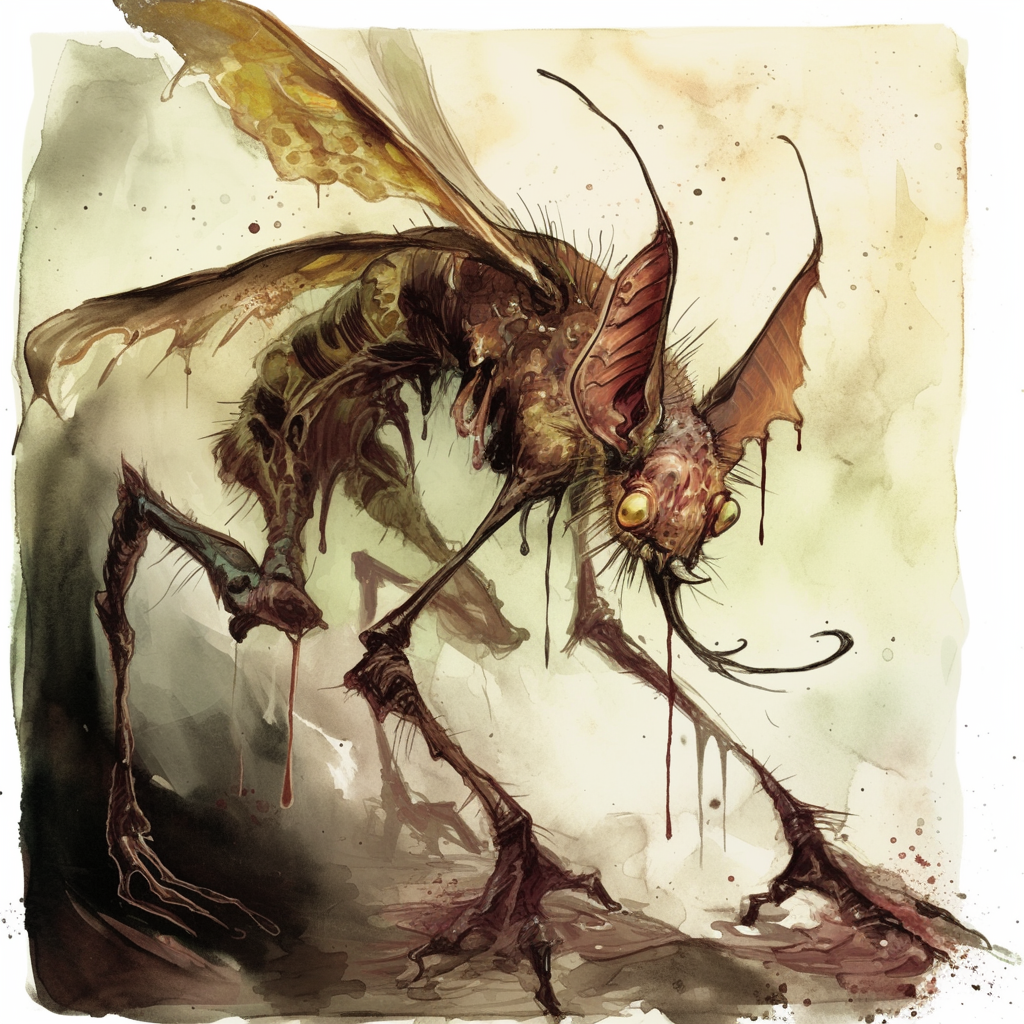Likhoradkas
Home Plane: Gray Waste / Oinos
Likhoradkas are the very embodiment of diseases; fiendish creatures originally born of the horrid Zhupela, proxy daughter of Stribog. The Slavic power of disease them further infected these creatures to create his army of pestilence. Their appearance and abilities are reminiscent of disease they represent. Their relationship to the yugoloth is dark—it could be that likhoradkas are really a type of ‘loth, or maybe they are some other, newer kind of fiend.
Oznoba

Likhoradkas of the grippe (influenza). The weakest of the likhoradkas, these fiends look like small bat-winged wretched humanoids, covered in frost and slime. Their attacks become more powerful in colder climates, but conversely weaker, if their victim keeps themselves warm. Oznobas have a sneeze-like attack which can cause immediate intense coughing in their victims that can prevent them from casting spells with verbal components.
Ogneya

Likhoradkas of dengue (tropical fever. These small, mosquito-like humanoid fiends are good flyers and can separate their bodies into the swarm of blood-sucking insects. Be wary of their bite for they transmit virulent diseases through their saliva. Fortunately, they are especially vulnerable to poisonous gases.
Gneteya

Likhoradkas of consumption (tuberculosis). Gneteya typically have arrogant attitudes and the look to go along with it. They typically take the shape of pale and weak women wearing white gowns, their lips bright red from the blood they cough up frequently. But don’t be mistaken by their apparent frailty—gneteyas are frighteningly fast and can resist many types of damage. Their most dangerous attack involves smothering their opponent with a blood-stained handkerchief, which weakens and exhausts their victims. Knowledgeable cutters can capitalise on their sunlight sensitivity and vulnerability to light-based attacks.
Kostolomka

Likhoradkas of lockjaw (tetanus). these fiends look like tall and gaunt monsters, covered in mud. Rusty iron spikes pierce their body everywhere, granting additional protection against melee attacks. They are able to pull out these spikes and wield them in melee or hurl them as ranged attacks (treat as a dagger). Such attacks from kostolomka induce agonising paralysis. However, these creatures are averse to clean air and take additional damage from wind-based attacks.
Korcheya

Likhoradkas of lyssa (rabies). These fiends can adopt different animal shapes, but their most common form is that of a hunchbacked humanoid with wolf face and bat wings. Their fur is pitch-black, and bluish glow runs across their spines, skull and eyes. Korcheya’s attacks cause fear or uncontrollable anger in whoever they strike. Fortunately korcheya are frightened when they see or hear running water (treat as a fear spell, with a saving throw).
Ospa

Likhoradkas of pox (smallpox). One of the more dangerous likhoradkas, “auntie Ospa” takes the form of an elderly woman with horrifying pustules in place of eyes. She can spread her disease both through strikes and by coughing up a cloud of foul miasmic matter. The pox caused by an opsa is highly contagious and spreads rapidly between humanoid victims. Fortunately, if a body succeeds their saving throw against this illness, or is infected and eventually recovers, they will have a much easier time next time they encounter an ospa.
Cattle’s death

Likhoradkas of anthrax. This likhoradka can change shapes as well, but inexplicably prefers the form of an emaciated cow, that looks almost like a skeleton. Its vicious bites cause horrible blistering wounds, and its toxic breath inflicts a horrible sickness. But the worst ability of this monster is the ability to evade death by turning into spores and infect the earth, lying dormant for years until disturbed. Once awoken from hibernation, the likhoradka spores will rapidly infect the unwitting victim, suffocating them, then stealing and possessing the body to use as the host once again. These spores can only be destroyed with fire, which also works well against cattle’s death.
Sources: Margarita and Jon Winter-Holt. Margarita notes: While this homebrew power is based on Slavic folklore and beliefs, the amount of actual information we have on pre-Christian Slavic deities is so minuscule that building any kind of lore out of it is impossible. However, there are a lot of folk beliefs about things these deities are thought to represent, which I have worked into the piece.

